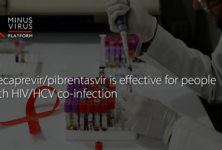An experimental immune-based therapy for chronic hepatitis B combined with tenofovir was safe and well-tolerated, but did not lead to greater reductions in hepatitis B surface antigen (HBsAg) than the antiviral alone, according to a study reported at the AASLD Liver Meeting this month in Boston.
Antiviral therapy using nucleoside/nucleotide analogs such as tenofovir disoproxil fumarate (Viread) or entecavir (Baraclude) is the mainstay of treatment for chronic hepatitis B. While these drugs can suppress hepatitis B virus(HBV) replication during therapy, they seldom lead to a cure as indicated by HBsAg loss and anti-HBs antibody seroconversion.
Chronic hepatitis B is associated with dysfunctional T-cell responses characterized by T-cell exhaustion, and immune-based therapies may help the immune system fight the virus. Improved T-cell responses could potentially reduce HBV DNA and HBsAg levels.
Harry Janssen from the Toronto Center for Liver Diseases and colleagues evaluated GS-4774, a yeast-based therapeutic T-cell vaccine containing a recombinant antigen with HBV core, surface, and X proteins, designed to elicit HBV-specific T-cell responses. The vaccine was previously shown to be immunogenic in mice and healthy human volunteers without hepatitis B, and it had a modest effect on HBsAg levels in chronic hepatitis B patients with suppressed HBV viral load.
This multicenter Phase 2 study evaluated GS-4774 in 195 chronic hepatitis B patients who were not currently on antiviral treatment. About 60% were men, most were Asian, and the median age was approximately 44 years. About a third had previously been treated for hepatitis B using either nucleoside/nucleotide antivirals or interferon.
About 40% of patients were hepatitis B “e” antigen (HBeAg)-positive, most had HBV genotypes B or C, and they did not have liver cirrhosis. At baseline they had HBV viral load above 2000 IU/mL, the mean HBV DNA level was approximately 5.8 log IU/mL, and the mean HBsAg level was 3.7 log IU/mL. About 70% had elevated alanine transaminase (ALT) levels.
Participants were randomly allocated to receive tenofovir DF alone or tenofovir plus 2, 10, or 40 “yeast units” of GS-4774 administered as 6 subcutaneous injections every 4 weeks through week 20.
The primary study endpoint was the change in HBsAg at week 24.
Results
- There was no significant difference in mean changes in HBsAg levels between patients in the tenofovir monotherapy arm and those treated with GS-4774 at week 24 or 48.
- There was also no significant difference in the proportions reaching undetectable HBV DNA at week 48 (69%-76%).
- More people in the GS-4774 arms saw a >0.5 log reduction in HBsAg at week 24, but by week 48 this was just as common in the tenofovir monotherapy arm as in the higher-dose GS-4774 groups (about 10%).
- Having a >0.5 log reduction in HBsAg was associated with higher baseline ALT, being HBeAg-positive, and having a specific genetic variation (HLA DRB*15:02).
- No participants achieved HBsAg loss.
- Among HBeAg-positive patients, only those treated with GS-4774 experienced HBeAg loss (5 people) or seroconversion (3 people).
- Treatment with GS-4774 was generally safe and well-tolerated, with no serious adverse events or discontinuations due to adverse events.
- The most frequently reported adverse event was injection site reactions, ranging from 37% in the lowest-dose GS-4774 arm to 86% in the highest-dose arm.
“GS-4774 in combination with tenofovir DF was safe and well-tolerated in patients with chronic HBV infection,” the researchers concluded, but “GS-4774 administration did not result in greater reductions in HBsAg.”
Janssen said that while the results were disappointing, negative studies are also informative. He suggested therapeutic vaccines are “still an interesting option” — likely as part of combination therapy, or used after other agents bring down HBV viral load — but it will be “a long and winding road to get a functional cure for hepatitis B.”
By Liz Highleyman
Source
HL Janssen, SK Yoon, EM Yoshida, et al. Safety and Efficacy of GS-4774 in combination with TDF in Patients with Chronic Hepatitis B not on Antiviral Medication. AASLD Liver Meeting. Boston, November 11-15, 2016. Abstract 231.


 ПОИСК ПО САЙТУ
ПОИСК ПО САЙТУ  поиск по ресурсному центру
поиск по ресурсному центру 



